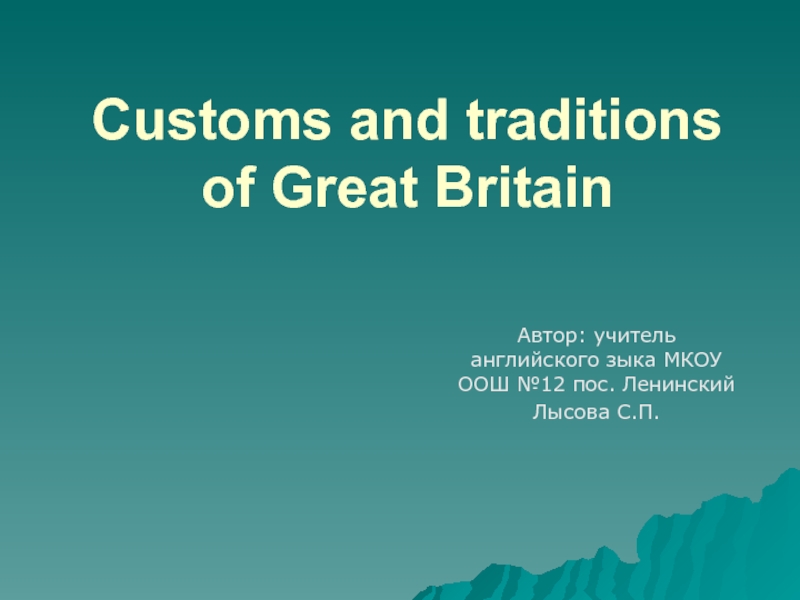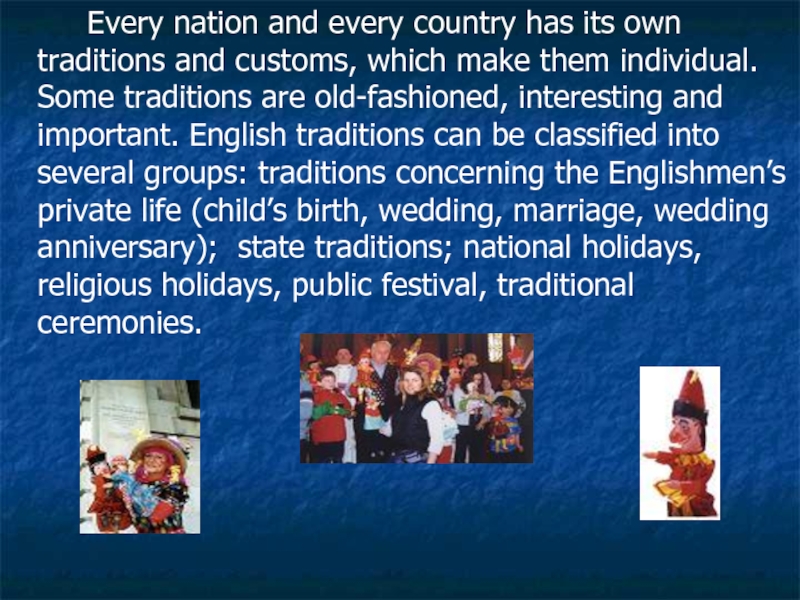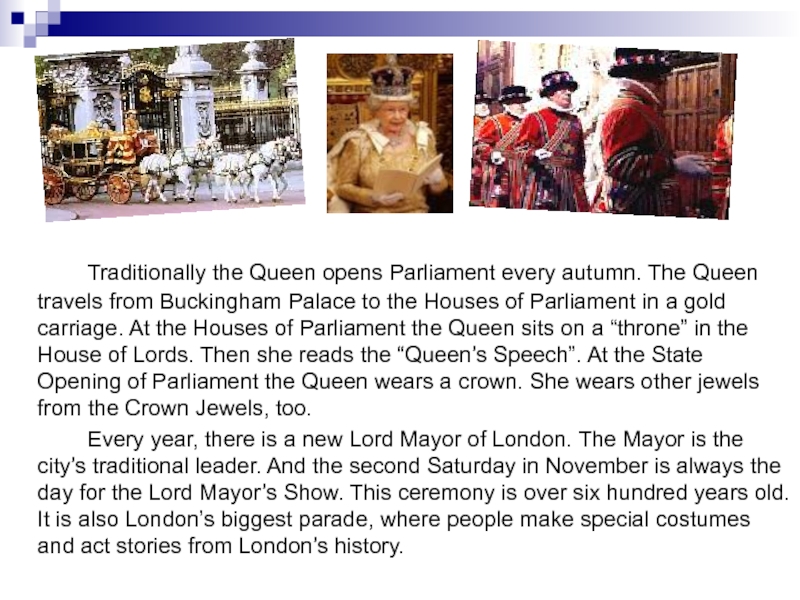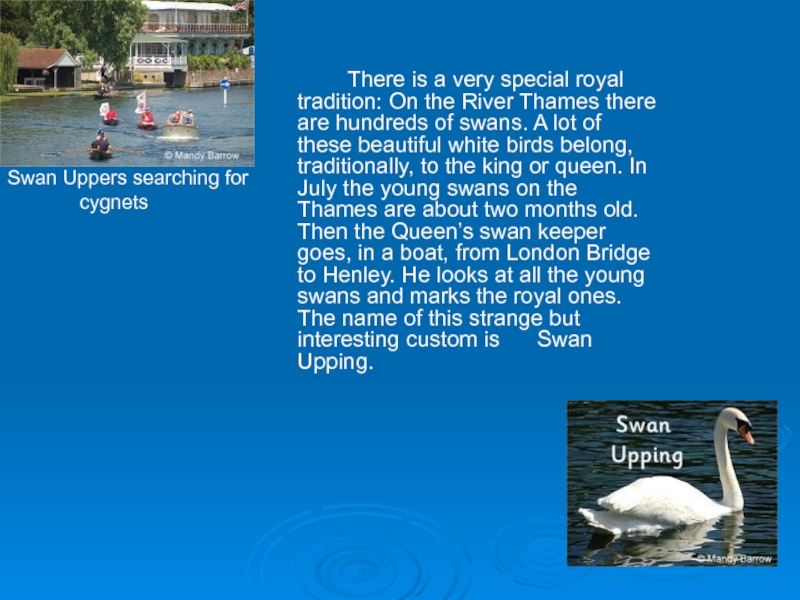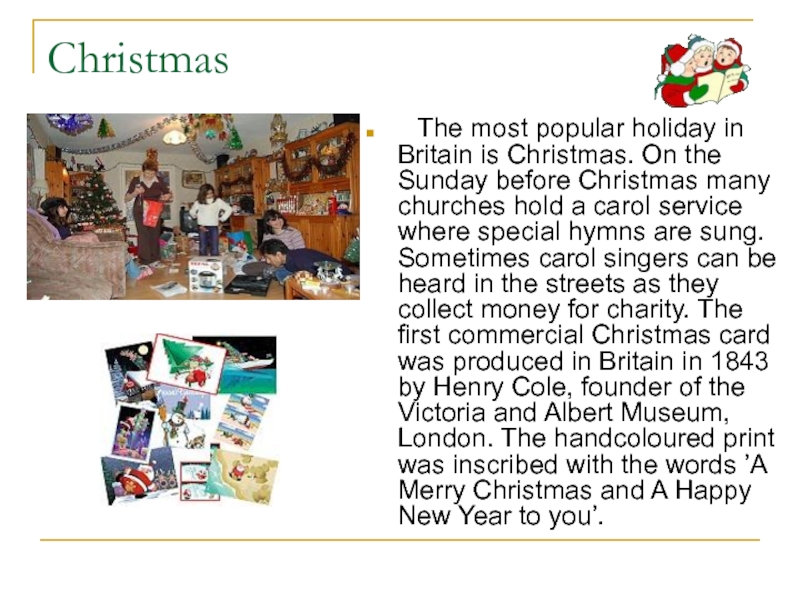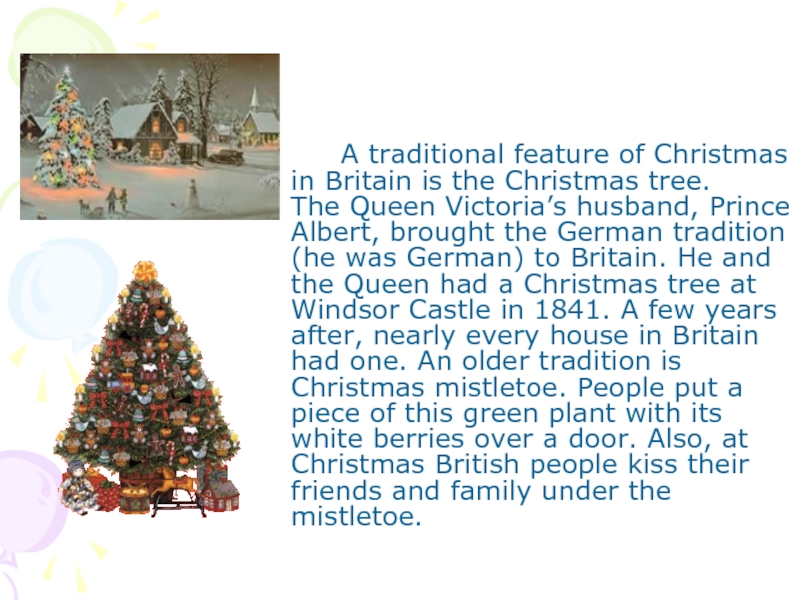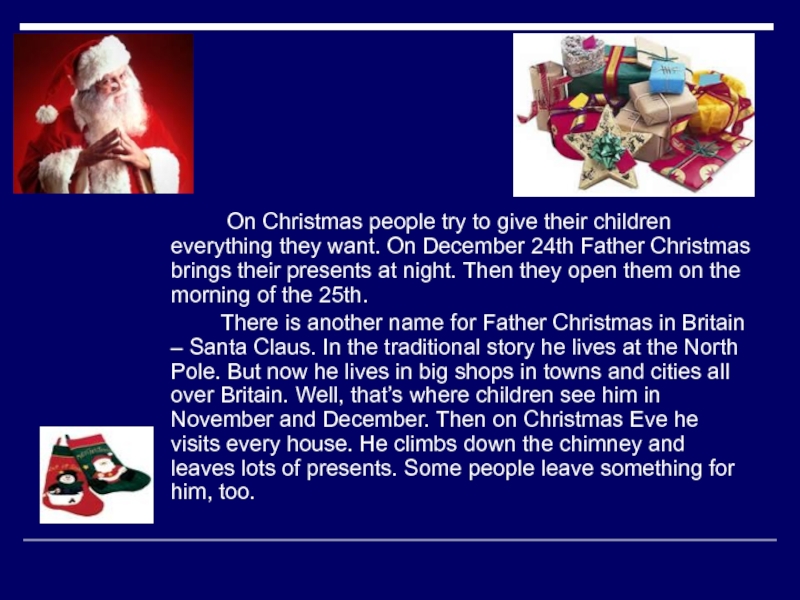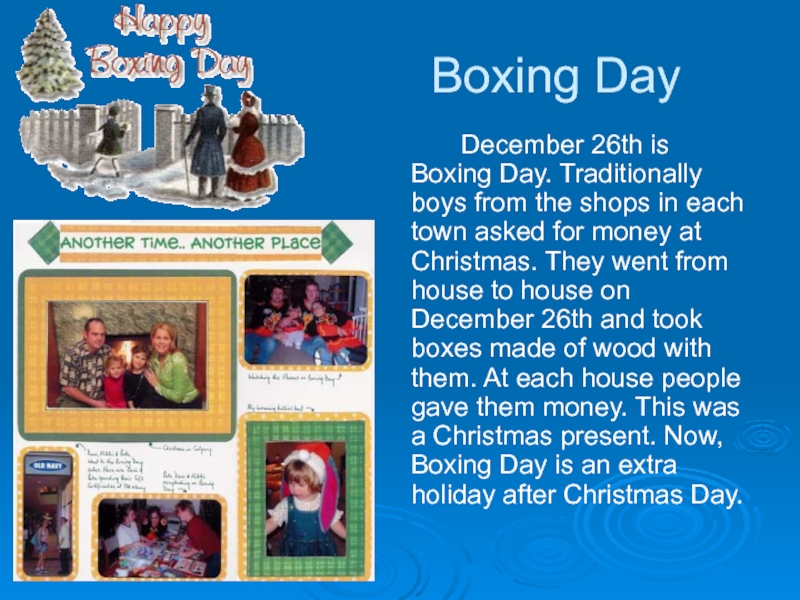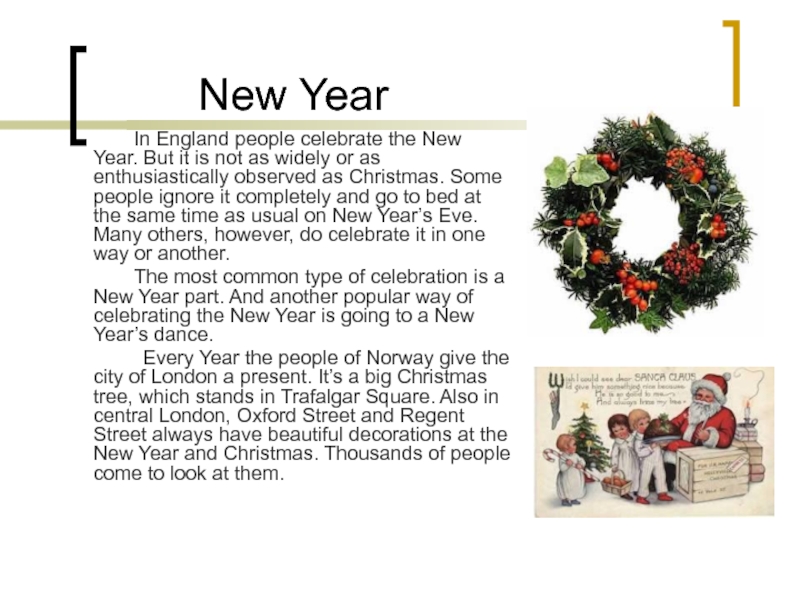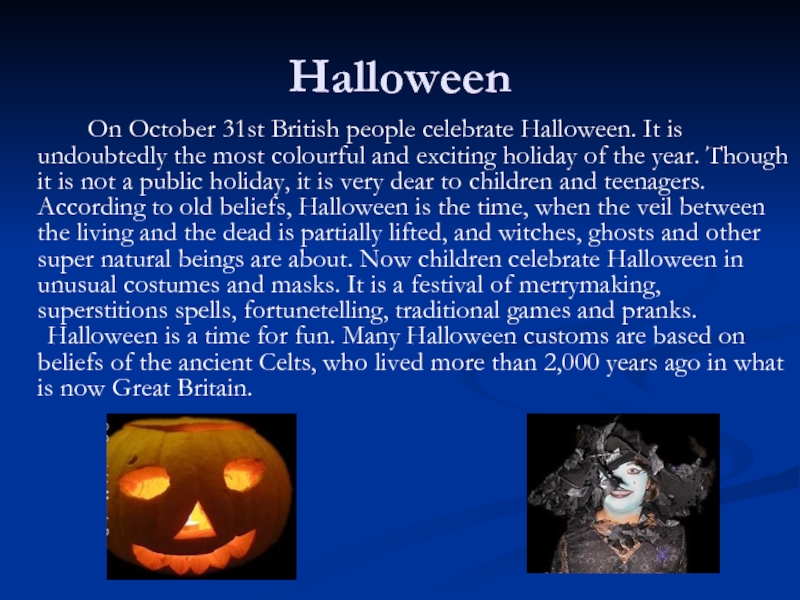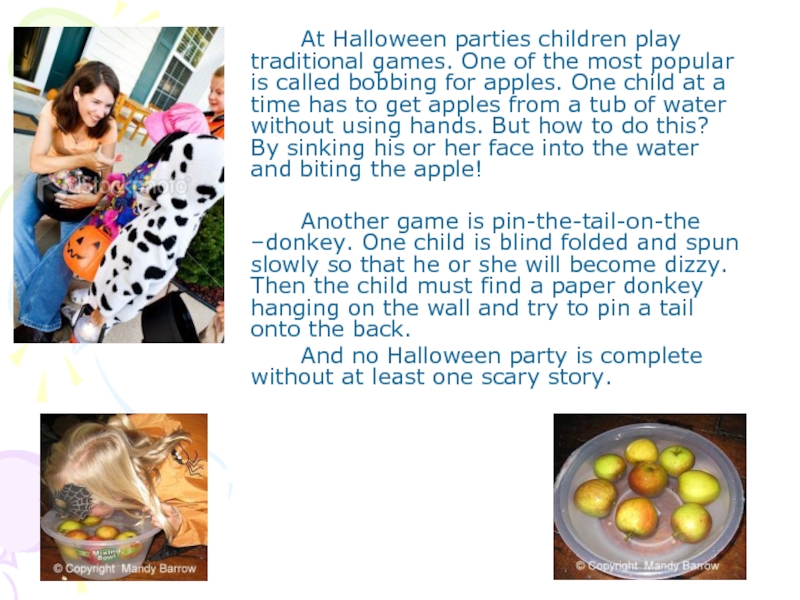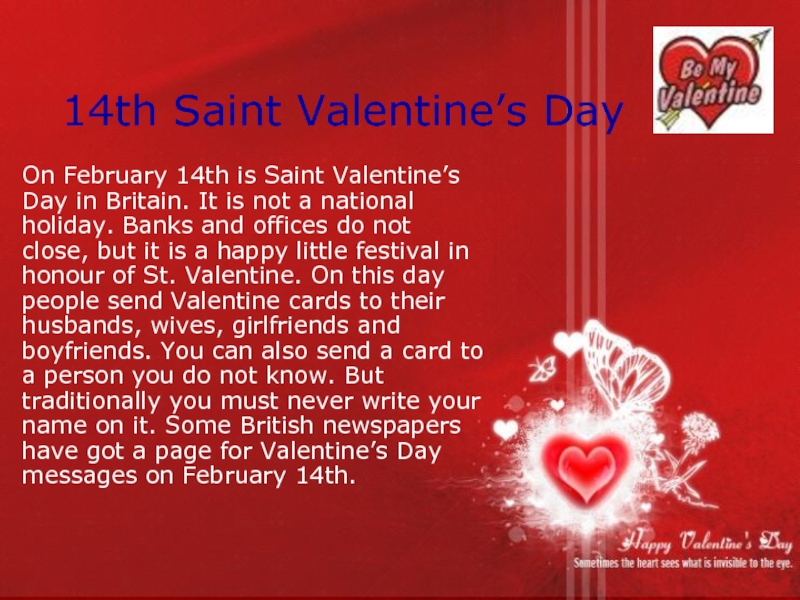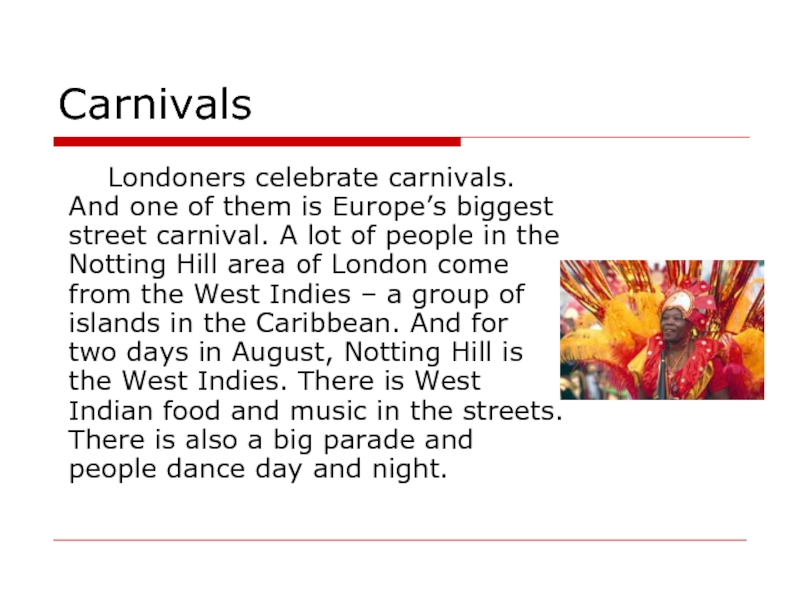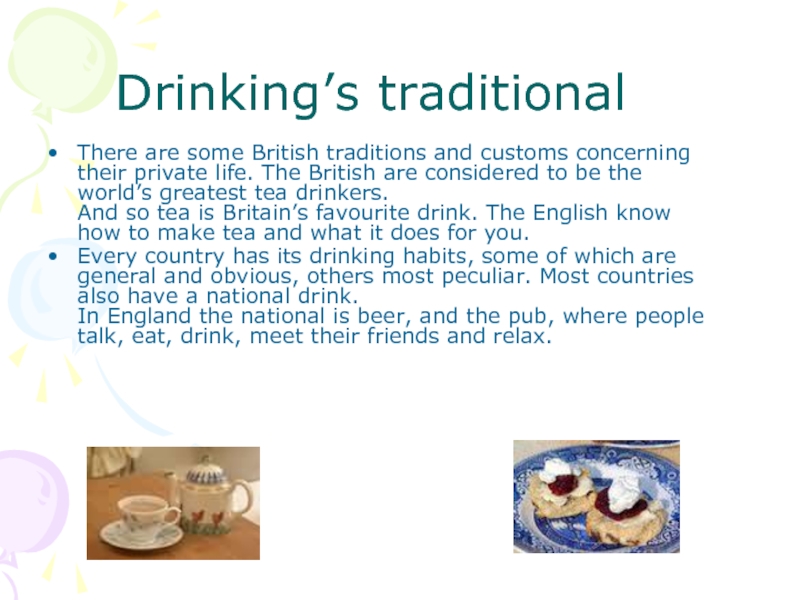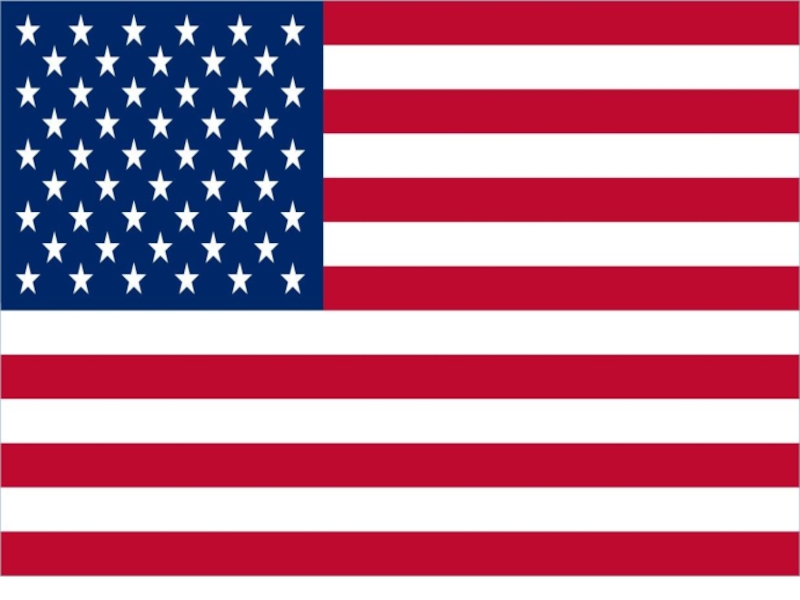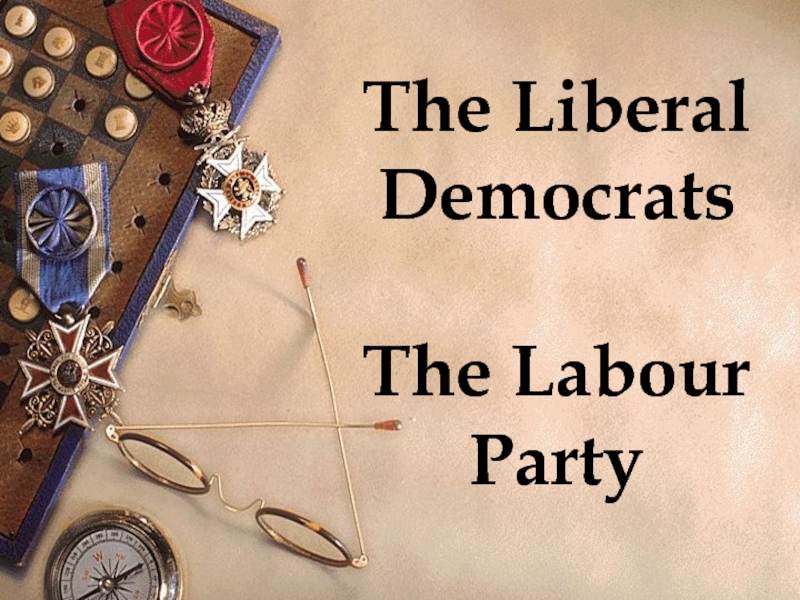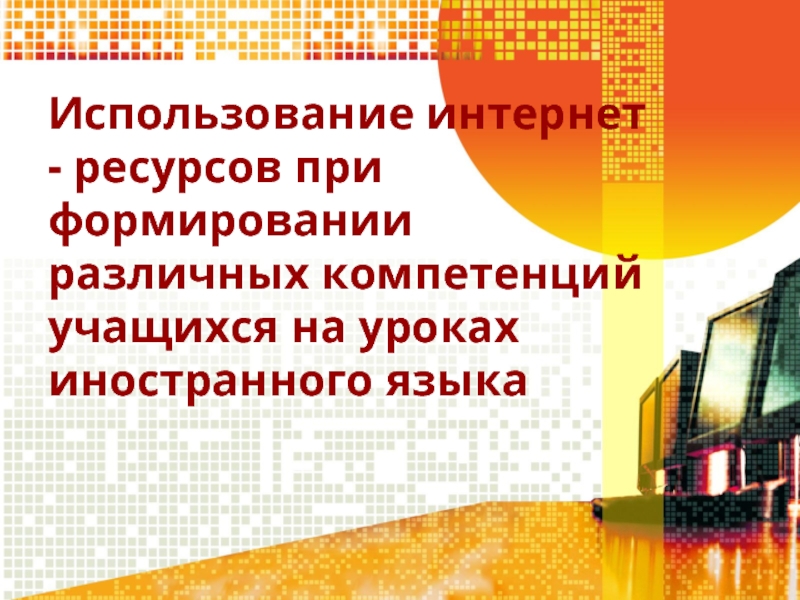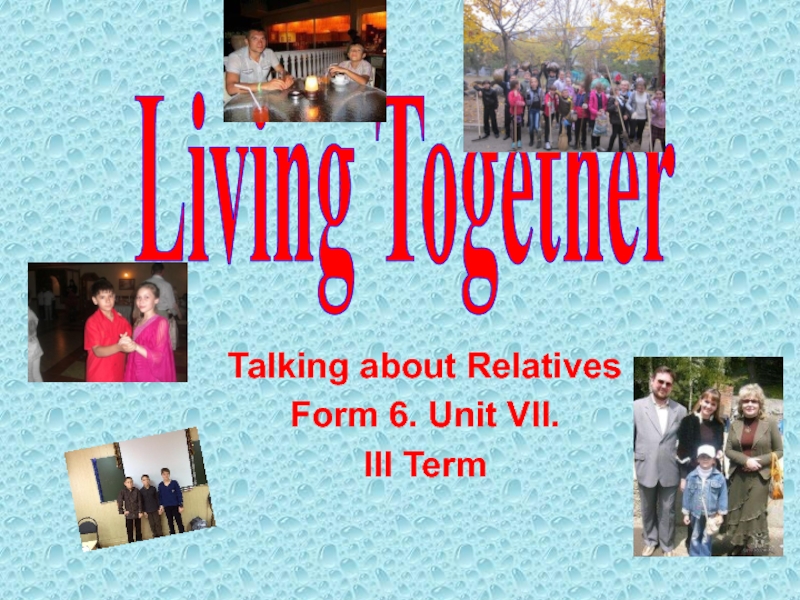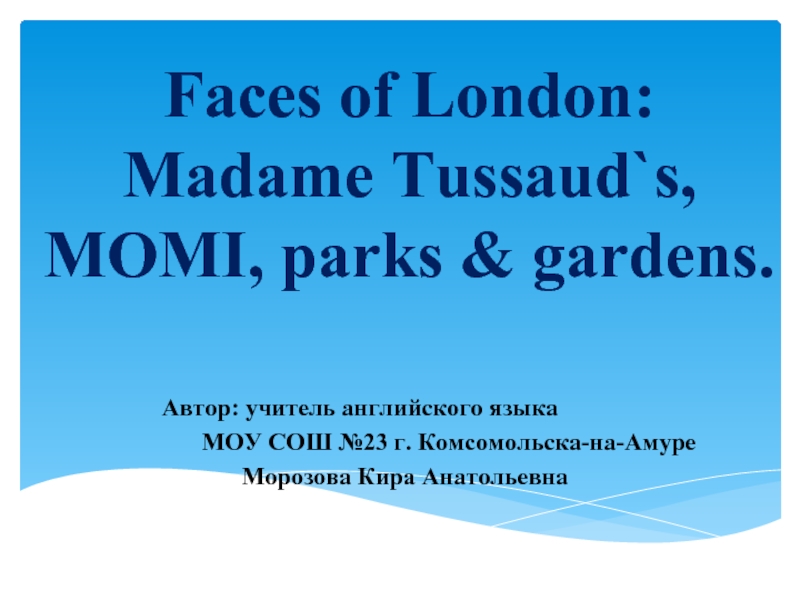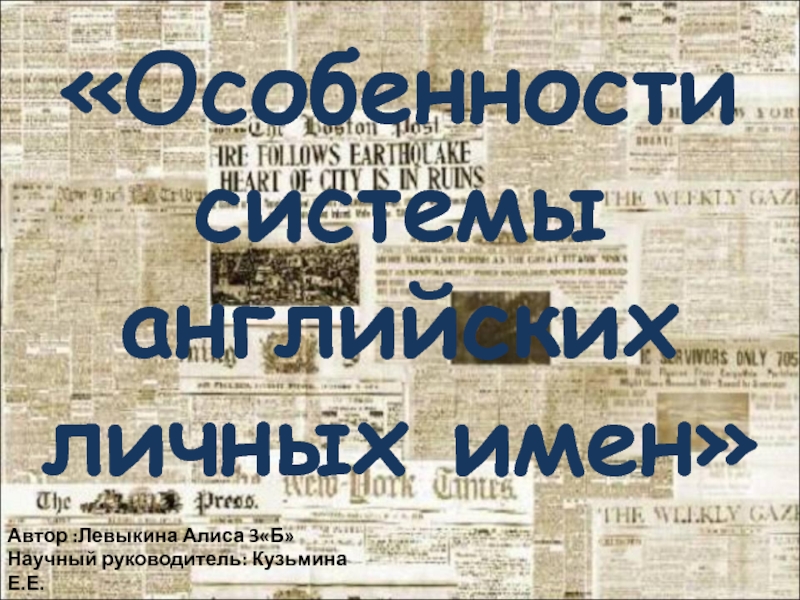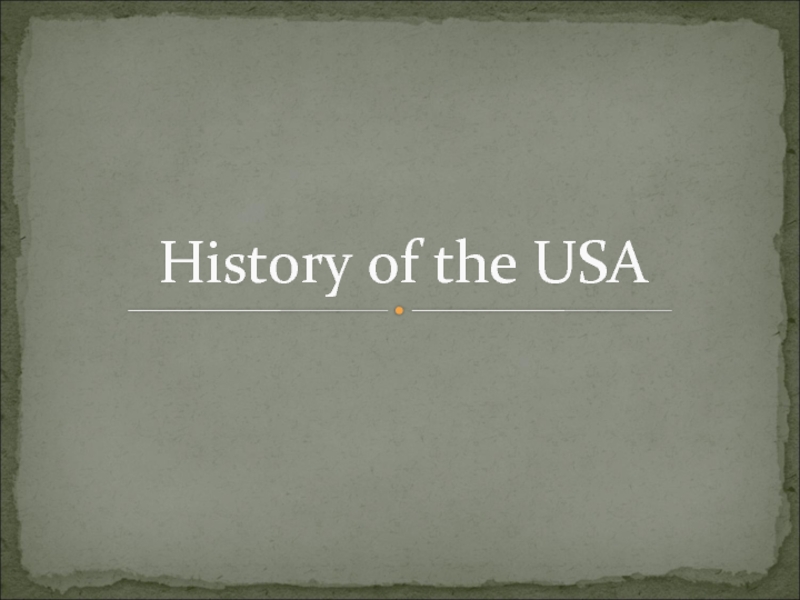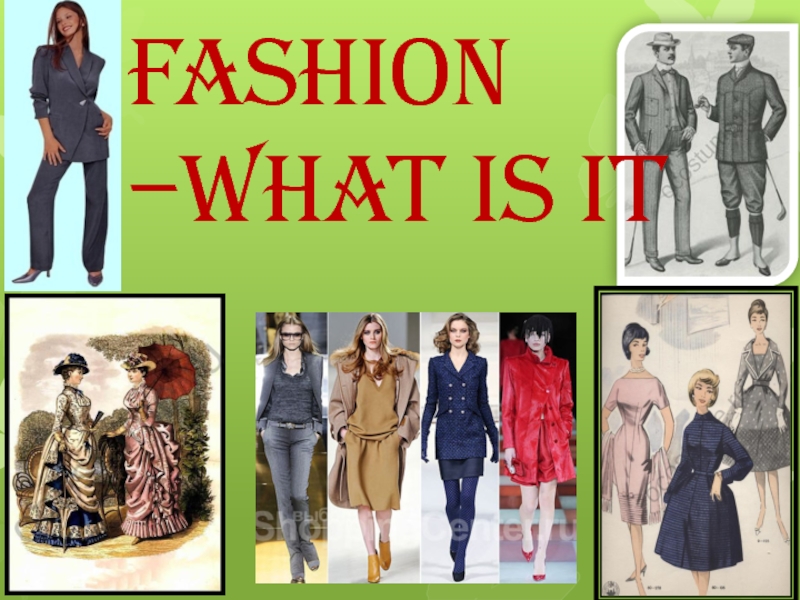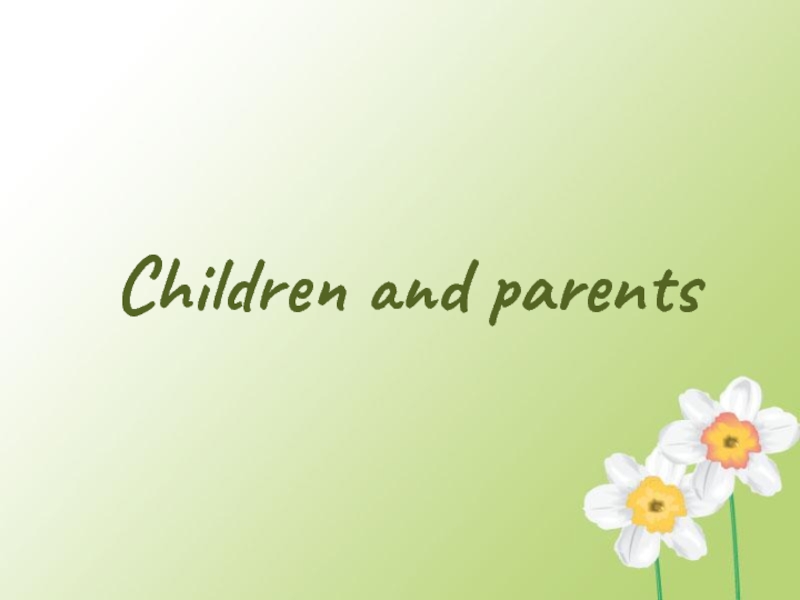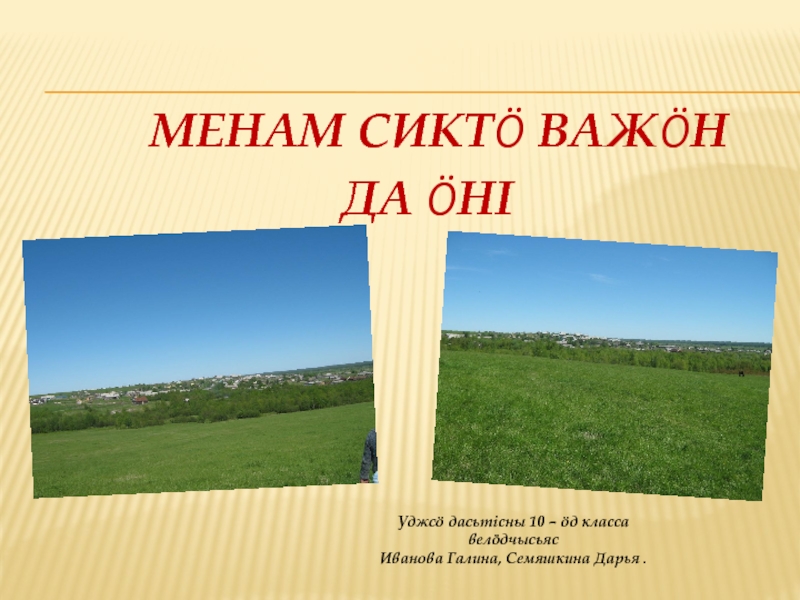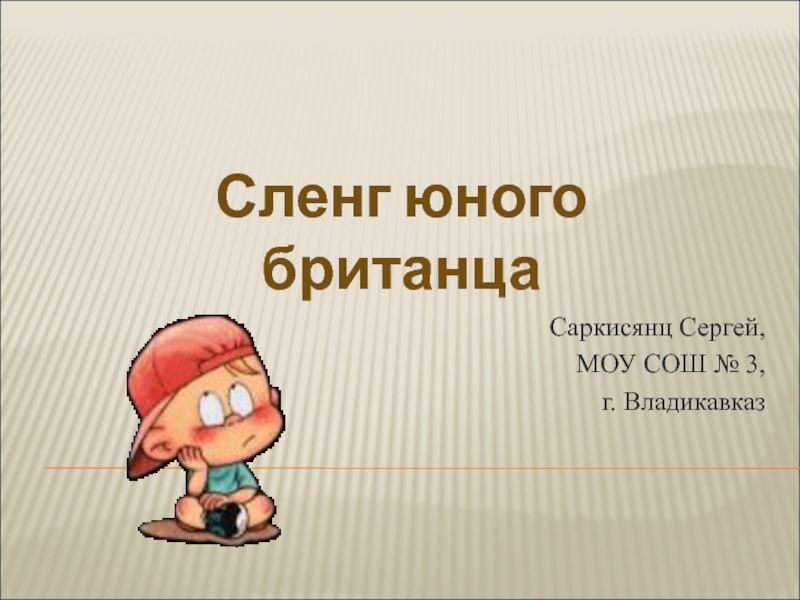Разделы презентаций
- Разное
- Английский язык
- Астрономия
- Алгебра
- Биология
- География
- Геометрия
- Детские презентации
- Информатика
- История
- Литература
- Математика
- Медицина
- Менеджмент
- Музыка
- МХК
- Немецкий язык
- ОБЖ
- Обществознание
- Окружающий мир
- Педагогика
- Русский язык
- Технология
- Физика
- Философия
- Химия
- Шаблоны, картинки для презентаций
- Экология
- Экономика
- Юриспруденция
Презентация к уроку английского языка по теме "Customs and traditions of Great Britain"
Содержание
- 1. Презентация к уроку английского языка по теме "Customs and traditions of Great Britain"
- 2. Every nation and every country has its
- 3. Royal traditions There are numerous royal traditions in
- 4. Traditionally the Queen opens Parliament every autumn.
- 5. There is a very special royal tradition:
- 6. HolidaysThere are only six public holidays a
- 7. Christmas The most popular holiday in
- 8. A traditional feature of Christmas in Britain
- 9. On Christmas people try to give
- 10. Слайд 10
- 11. New Year
- 12. Halloween On October 31st British people celebrate
- 13. At Halloween parties children play traditional games.
- 14. 14th Saint Valentine’s Day On February 14th
- 15. Carnivals Londoners celebrate carnivals. And one of
- 16. Fool’s Day April 1st is April Fool’s
- 17. Drinking’s traditionalThere are some British
- 18. Manners and Etiquette Hundreds of years ago,
- 19. Скачать презентанцию
Every nation and every country has its own traditions and customs, which make them individual. Some traditions are old-fashioned, interesting and important. English traditions can be classified into several groups: traditions
Слайды и текст этой презентации
Слайд 1Customs and traditions of Great Britain
Автор: учитель английского зыка МКОУ
ООШ №12 пос. Ленинский
Слайд 2 Every nation and every country has its own traditions and
customs, which make them individual. Some traditions are old-fashioned, interesting
and important. English traditions can be classified into several groups: traditions concerning the Englishmen’s private life (child’s birth, wedding, marriage, wedding anniversary); state traditions; national holidays, religious holidays, public festival, traditional ceremonies.Слайд 3Royal traditions
There are numerous royal traditions in Britain, some are
ancient, others are modern.
The Queen is the only person in
Britain who has two birthdays. Her real birthday is on April 21st, but she has an “official” birthday, too, which is on the second Saturday in June. On this day, there is a traditional ceremony called the Trooping of the Colour. It is a big parade with brass bands and hundreds of soldiers in London. Thousands of Londoners and visitors watch in Horse Guards’ Parade while other millions of people at home watch it on television. Слайд 4 Traditionally the Queen opens Parliament every autumn. The Queen travels
from Buckingham Palace to the Houses of Parliament in a
gold carriage. At the Houses of Parliament the Queen sits on a “throne” in the House of Lords. Then she reads the “Queen’s Speech”. At the State Opening of Parliament the Queen wears a crown. She wears other jewels from the Crown Jewels, too.Every year, there is a new Lord Mayor of London. The Mayor is the city’s traditional leader. And the second Saturday in November is always the day for the Lord Mayor’s Show. This ceremony is over six hundred years old. It is also London’s biggest parade, where people make special costumes and act stories from London’s history.
Слайд 5 There is a very special royal tradition: On the River
Thames there are hundreds of swans. A lot of these
beautiful white birds belong, traditionally, to the king or queen. In July the young swans on the Thames are about two months old. Then the Queen’s swan keeper goes, in a boat, from London Bridge to Henley. He looks at all the young swans and marks the royal ones. The name of this strange but interesting custom is Swan Upping.Swan Uppers searching for
cygnets
Слайд 6Holidays
There are only six public holidays a year in Great
Britain, that is days on which people need not go
in to work. They are: Christmas Day, Good Friday, Easter Monday, Spring Bank Holiday and Late Summer Bank Holiday.Слайд 7Christmas
The most popular holiday in Britain is Christmas.
On the Sunday before Christmas many churches hold a carol
service where special hymns are sung. Sometimes carol singers can be heard in the streets as they collect money for charity. The first commercial Christmas card was produced in Britain in 1843 by Henry Cole, founder of the Victoria and Albert Museum, London. The handcoloured print was inscribed with the words ’A Merry Christmas and A Happy New Year to you’.Слайд 8 A traditional feature of Christmas in Britain is the Christmas
tree. The Queen Victoria’s husband, Prince Albert, brought the German tradition
(he was German) to Britain. He and the Queen had a Christmas tree at Windsor Castle in 1841. A few years after, nearly every house in Britain had one. An older tradition is Christmas mistletoe. People put a piece of this green plant with its white berries over a door. Also, at Christmas British people kiss their friends and family under the mistletoe.Слайд 9 On Christmas people try to give their children everything
they want. On December 24th Father Christmas brings their presents
at night. Then they open them on the morning of the 25th.There is another name for Father Christmas in Britain – Santa Claus. In the traditional story he lives at the North Pole. But now he lives in big shops in towns and cities all over Britain. Well, that’s where children see him in November and December. Then on Christmas Eve he visits every house. He climbs down the chimney and leaves lots of presents. Some people leave something for him, too.
Слайд 10
Boxing Day
December 26th is Boxing Day. Traditionally boys
from the shops in each town asked for money at Christmas. They went from house to house on
December 26th and took boxes made of wood with them. At each house people gave them money. This was a Christmas present. Now, Boxing Day is an extra holiday after Christmas Day.Слайд 11 New Year
In England people
celebrate the New Year. But it is not as widely
or as enthusiastically observed as Christmas. Some people ignore it completely and go to bed at the same time as usual on New Year’s Eve. Many others, however, do celebrate it in one way or another.The most common type of celebration is a New Year part. And another popular way of celebrating the New Year is going to a New Year’s dance.
Every Year the people of Norway give the city of London a present. It’s a big Christmas tree, which stands in Trafalgar Square. Also in central London, Oxford Street and Regent Street always have beautiful decorations at the New Year and Christmas. Thousands of people come to look at them.
Слайд 12Halloween
On October 31st British people celebrate Halloween. It is
undoubtedly the most colourful and exciting holiday of the year.
Though it is not a public holiday, it is very dear to children and teenagers. According to old beliefs, Halloween is the time, when the veil between the living and the dead is partially lifted, and witches, ghosts and other super natural beings are about. Now children celebrate Halloween in unusual costumes and masks. It is a festival of merrymaking, superstitions spells, fortunetelling, traditional games and pranks. Halloween is a time for fun. Many Halloween customs are based on beliefs of the ancient Celts, who lived more than 2,000 years ago in what is now Great Britain.Слайд 13 At Halloween parties children play traditional games. One of the
most popular is called bobbing for apples. One child at
a time has to get apples from a tub of water without using hands. But how to do this? By sinking his or her face into the water and biting the apple!Another game is pin-the-tail-on-the –donkey. One child is blind folded and spun slowly so that he or she will become dizzy. Then the child must find a paper donkey hanging on the wall and try to pin a tail onto the back.
And no Halloween party is complete without at least one scary story.
Слайд 1414th Saint Valentine’s Day
On February 14th is Saint Valentine’s
Day in Britain. It is not a national holiday. Banks
and offices do not close, but it is a happy little festival in honour of St. Valentine. On this day people send Valentine cards to their husbands, wives, girlfriends and boyfriends. You can also send a card to a person you do not know. But traditionally you must never write your name on it. Some British newspapers have got a page for Valentine’s Day messages on February 14th.Слайд 15Carnivals
Londoners celebrate carnivals. And one of them is Europe’s
biggest street carnival. A lot of people in the Notting
Hill area of London come from the West Indies – a group of islands in the Caribbean. And for two days in August, Notting Hill is the West Indies. There is West Indian food and music in the streets. There is also a big parade and people dance day and night.Слайд 16Fool’s Day
April 1st is April Fool’s Day in Britain.
This is a very old tradition from the Middle Ages
(between the fifth and fifteenth centuries). At that time the servants were masters for one day of the year. They gave orders to their masters, and their masters had to obey.Now April Fool’s Day is different. It is a day for jokes and tricks.
Слайд 17 Drinking’s traditional
There are some British traditions and customs
concerning their private life. The British are considered to be
the world’s greatest tea drinkers. And so tea is Britain’s favourite drink. The English know how to make tea and what it does for you.Every country has its drinking habits, some of which are general and obvious, others most peculiar. Most countries also have a national drink. In England the national is beer, and the pub, where people talk, eat, drink, meet their friends and relax.
Слайд 18 Manners and Etiquette
Hundreds of years ago, soldiers began this
custom. They shook hands to show that they did not
have a sword. Now, shaking hands is a custom in most countries.Englishmen shake hands only when they are introduced, or after a long absence.
Victorian England made nearly as many rules about hand shaking as the Chinese did about bowing. A man could not offer his hand first a lady; young ladies did not shake men’s hands at all unless they were old friends; married ladies could offer their hands in a room, but not in public, where they would bow slightly.
